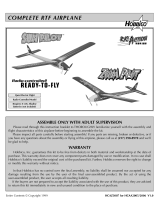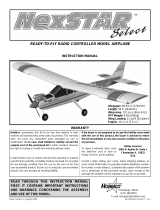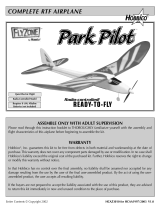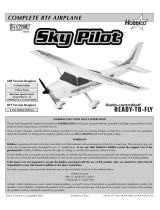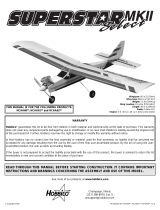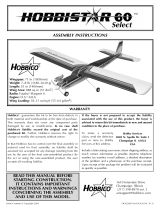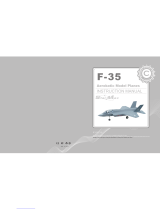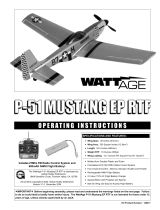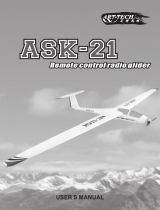Page is loading ...

Hobbico
®
Model Manufacturing Co. guarantees this kit to be
free from defects in both material and workmanship at the date
of purchase. This warranty does not cover any component parts
damaged by use or modifi cation. In no case shall Hobbico’s
liability exceed the original cost of the purchased kit. Further,
Hobbico reserves the right to change or modify this warranty
without notice.
In that Hobbico has no control over the fi nal assembly or material
used for fi nal assembly, no liability shall be assumed nor accepted
for any damage resulting from the use by the user of the fi nal
user-assembled product. By the act of using the user-assembled
product, the user accepts all resulting liability.
If the buyer is not prepared to accept the liability associated
with the use of this product, the buyer is advised to return
this kit immediately in new and unused condition to the place
of purchase.
To make a warranty claim send the defective part or item to Hobby
Services at the address below:
Hobby Services
3002 N. Apollo Dr., Suite 1
Champaign, IL 61822 USA
Include a letter stating your name, return shipping address, as
much contact information as possible (daytime telephone number,
fax number, e-mail address), a detailed description of the problem
and a photocopy of the purchase receipt. Upon receipt of the
package, the problem will be evaluated as quickly as possible.
READ THROUGH THIS MANUAL BEFORE
STARTING CONSTRUCTION. IT CONTAINS
IMPORTANT INSTRUCTIONS AND WARNINGS
CONCERNING THE ASSEMBLY AND USE OF
THIS MODEL.
Champaign, Illinois
(217) 398-8970, Ext 5
E-mail: airsupport@hobbico.com
WARRANTY
INSTRUCTION MANUAL
Entire Contents © Copyright 2007 HCAA0935 for HCAA09** V1.0
Wingspan: 68.5 in [1740mm]
Wing Area: 722 sq in [46.6dm
2
]
RTF Weight: 7.0 – 8.5 lb [3175 – 3855g]
Wing Loading: 22 – 27 oz/sq ft [68 – 83g/dm
2
]
Length: 56 in [1410mm]
Motor: RimFire 42-50-800

2
TABLE OF CONTENTS
INTRODUCTION ............................................................... 2
ACADEMY OF MODEL AERONAUTICS (AMA) .............. 2
SPECIFICATION & DESCRIPTION CHANGES ............... 3
SAFETY PRECAUTIONS ................................................. 3
ADDITIONAL REQUIRED ITEMS .................................... 3
Hardware & Accessories ............................................ 3
Optional Supplies & Tools .......................................... 4
ORDERING REPLACEMENT PARTS .............................. 4
COMMON ABBREVIATIONS ........................................... 4
KIT INSPECTION .............................................................. 5
KIT CONTENTS ................................................................ 5
A GUIDE TO THE NEXSTAR EP SELECT FEATURES ... 6
Brushless Power System ........................................... 6
CenterCore
™
Wing Rib ............................................... 6
SpinControl
™
Airfoil Extensions .................................. 6
SpeedBrakes
™
Training Flaps .................................... 6
PivotFlex
™
Wing Mounting System ............................ 7
EasyAlign
™
Tail Mounting System .............................. 7
SnapGear
™
Landing Gear .......................................... 7
Futaba
®
PA-2 Pilot Assist Link ................................... 7
RealFlight
®
NexStar Edition ....................................... 8
ASSEMBLY ....................................................................... 8
Charge the Batteries .................................................. 8
Assemble the Wing .................................................... 9
Install the Landing Gear ........................................... 10
Install the Tail Surfaces ............................................ 10
Install the Motor Batteries ........................................ 11
SET-UP ............................................................................ 12
Center the Control Surfaces..................................... 12
Check Control Surface Directions ............................ 14
Arming the Motor ..................................................... 15
Check the Control Throws ........................................ 15
Identify Your Model ................................................... 15
Balance the Model (C.G. - Center of Gravity) .......... 16
Balance the Model Laterally ..................................... 16
Setting Up the Futaba
®
PA-2 Pilot Assist Link .......... 16
Adjusting the PA-2 from Your Transmitter ................. 19
FINAL PREPARATIONS ................................................. 20
Gather the Necessary Tools ..................................... 20
Other Useful Items ................................................... 20
At-The-Shop Check List ........................................... 20
FLIGHT PREPARATIONS ............................................... 20
Check the Frequency ............................................... 20
Check the Controls .................................................. 21
Range Check the Radio ........................................... 21
FLYING ............................................................................ 21
Taxiing ...................................................................... 21
Takeoff ..................................................................... 21
Flight ........................................................................ 22
Landing .................................................................... 22
MAINTENANCE TIPS ..................................................... 22
Covering ................................................................... 22
Propeller ................................................................... 22
AFTER YOU MASTER THE NEXSTAR EP SELECT
IN ITS ORIGINAL FORM ................................................ 23
SpeedBrakes Training Flaps .................................... 23
SpinControl Airfoil Extensions .................................. 23
Dual Aileron Servos ................................................. 23
Flaperons ................................................................. 24
Dual Aileron Servos & Flaps .................................... 25
AMA SAFETY CODE (excerpts) .................................... 26
General .................................................................... 26
Radio Control ........................................................... 26
PRE-FLIGHT CHECK LIST ............................................ 26
NEXSTAR EP SELECT SUCCESS GUARANTEE ......... 27
INTRODUCTION
Thank you for purchasing the Hobbico NexSTAR
™
EP Select,
the next generation in Radio Control Trainers. You’ve made
the right decision by purchasing a “real” model airplane
equipped with a state-of-the-art brushless electric motor, a
6-channel radio, the Futaba
®
PA-2 Pilot Assist Link system,
and the latest in aerodynamic and assembly technologies.
Once assembled and set up, there will be no fi ddling with a
temperamental engine or constant troubleshooting to fi gure
out how to get the model to fl y. Under the guidance of an
experienced fl ight instructor, all you’ll have to do is concentrate
on learning to fl y. And after you’ve mastered the NexSTAR EP
Select, the motor, ESC (electronic speed control), and radio
system may be transferred to your next model!
We at Hobbico know how exciting a new plane purchase can
be and we know you’re anxious to get started, but please
take the time to read these instructions before attempting to
build and operate your model.
There are three parts to this manual. The fi rst part contains
a guide to the unique features of the NexSTAR EP Select,
followed by four pages of easy assembly. Lastly, a set-up guide
takes you through initial adjustments and fl ight preparation. Do
not overlook any of the important set-up procedures and be
sure to follow the instructions all the way to the end. Anything
skipped in the shop will have to be done at the fi eld anyway.
ACADEMY OF MODEL
AERONAUTICS (AMA)
If this is your fi rst endeavor in the world of radio-controlled
fl ight, we strongly recommend that you join the AMA (Academy
of Model Aeronautics) and a local R/C club. The AMA is the
governing body of model aviation and membership is required
to fl y at AMA clubs. Joining the AMA provides many benefi ts
but one of the primary reasons to join is liability protection.
The AMA can also direct you to the closest R/C club whose
membership includes qualifi ed instructors.
The best thing you can do to insure success is to fi nd a fl ight
instructor who will inspect your model for air-worthiness
and provide fl ying lessons. It cannot be stated strongly
enough that, if you do not already know how to fl y an R/C
airplane, you will probably not be able to fl y this model by
yourself. It may appear to be easy, but over-controlling and
disorientation quickly overcome inexperienced fl iers, swiftly
ending their fi rst fl ight. Many have tried to teach themselves,
but most become discouraged and end up quitting the hobby,
or destroy several models before they are ready to solo.

3
Contact your local hobby shop and ask them to introduce you
to an instructor or an R/C club representative. There are over
2,500 AMA chartered clubs across the USA. If there is no
club or experienced R/C pilot nearby, it would be worth even
a long drive to fi nd one–if only for just a few fl ight lessons
(then you’ll have an idea of what to expect). If there is no
hobby shop in your area, contact the AMA at the address or
toll-free phone number below.
Academy of Model Aeronautics
5151 East Memorial Drive
Muncie, IN 47302-9252
Tele. (800) 435-9262
Fax (765) 741-0057
Or via the Internet at:
http://www.modelaircraft.org
Insurance coverage provided by the AMA is not limited to
fl ying at contests or on the club fi eld, but even applies to fl ying
at public demonstrations and air shows. Failure to comply with
the AMA Safety Code (excerpts can be found on page 26 of
this manual) may endanger insurance coverage.
IMPORTANT!! Two of the most important things you can do
to preserve the radio controlled aircraft hobby are to avoid
fl ying near full-scale aircraft and avoid fl ying near or over
groups of people.
SPECIFICATION & DESCRIPTION
CHANGES
All pictures, descriptions, and specifi cations found in this
instruction manual are subject to change without notice.
Hobbico maintains no responsibility for inadvertent errors in
this manual.
For the latest technical updates or manual corrections for the
NexSTAR EP Select, visit the Hobbico web site listed below
and select the NexSTAR EP Select. A “Tech Notice” box will
appear in the upper left corner of the page if there is new
technical information or changes to the kit.
http://www.hobbico.com/airplanes/index.html
PROTECT YOUR MODEL, YOURSELF
& OTHERS...FOLLOW THESE
IMPORTANT SAFETY PRECAUTIONS
• Your NexSTAR EP Select should not be considered a toy,
but rather a sophisticated, working model that functions very
much like a full-size airplane. Because of its performance
capabilities, the NexSTAR EP Select, if not assembled and
operated properly, could cause injury to yourself, spectators,
and/or damage to property.
• You must assemble the model according to the
instructions. Do not alter or modify the model, as doing so
may result in an unsafe or unfl yable model. In a few cases the
instructions may differ slightly from drawings or sketches. In
those instances the written instructions should be considered
as correct.
• You must check the operation of the model before every
fl ight to insure that all equipment is operating and that the
model has remained structurally sound. Be sure to check
clevises or other connectors often and replace them if they
show any signs of wear or fatigue.
• If you are not already an experienced R/C pilot, you should
fl y the model only with the help of an experienced R/C pilot.
We, as the kit manufacturer, provide you with a top quality
kit and instructions, but ultimately the quality and fl yability
of your fi nished model depends on how you build it;
therefore, we cannot in any way guarantee the performance
of your completed model, and no representations are
expressed or implied as to the performance or safety of
your completed model.
• Before starting to build, inspect the parts in this kit to
make sure that they are of acceptable quality. If any parts
are not of acceptable quality, or if you need assistance with
assembly, contact:
Hobbico Product Support
Phone: (217) 398-8970, ext. 5
Fax: (217) 398-7721
E-mail: [email protected]
If the buyer is not prepared to accept the liability associated
with the use of this product, the buyer is advised to return this
kit in new and unused condition to the place of purchase.
ADDITIONAL REQUIRED ITEMS
Hardware & Accessories
The following is a list of accessories required to make the NexSTAR
EP Select operational. Order numbers are in parentheses.
❏ (2) 8-Cell 9.6V 3600 mAh NiMH (Nickel-Metal Hydride)
battery packs (GPMP0362)
❏ Hobbico Dual Peak NiMH Charger (HCAP0255)
The NexSTAR EP Select can also be fl own with a 5-cell
Lithium-Polymer (LiPo) set up. If you decide to go with LiPo
batteries, you will need the following items:
❏ *2S 3200mAh 7.4V 20C Discharge w/Balance (GPMP0622)
❏ *3S 3200mAh 11.1V 20C Discharge w/Balance (GPMP0623)
(*Use them together for a 5S set-up)

A cell balancer is highly recommended for the battery
packs listed above:
❏ Great Planes Electrifl y
™
Equinox
™
Cell Balancer
1 to 5 (GPMM3160)
A suitable charger is also required:
The Great Planes PolyCharge4
™
(GPMM3015) is designed
for LiPo packs only, but is able to charge four LiPo packs
simultaneously. The Great Planes Triton
™
2 (GPMM3153)
charger will only charge one pack at a time, but is capable of
charging NiCd, NiMH, LiPo and lead acid batteries.
Optional Supplies & Tools
Here is a list of optional tools mentioned in the manual that
will help you prepare the NexSTAR EP Select for fl ight.
❏ C.G. Machine
™
(GPMR2400)
❏ Precision Magnetic Propeller Balancer (TOPQ5700)
❏ Stick-On Segmented Lead Weights (GPMQ4485)
❏ Top Flite
®
MonoKote
®
Sealing Iron (TOPR2100)
❏ Top Flite Hot Sock
™
Iron Cover (TOPR2175)
❏ Robart Super Stand II (ROBP1402)
ORDERING REPLACEMENT PARTS
Replacement parts for the NexSTAR EP Select are available
using the order numbers in the Replacement Parts List that
follows. The fastest, most economical service can be provided
by your hobby dealer or mail-order company.
To locate a hobby dealer, visit the Hobbico web site at
www.hobbico.com. Choose “Where to Buy” at the bottom of
the menu on the left side of the page. Follow the instructions
provided on the page to locate a U.S., Canadian, or
International dealer.
Parts may also be ordered directly from Hobby Services by
calling (217) 398-0007 or via facsimile at (217) 398-7721, but
full retail prices and shipping and handling charges will apply.
Illinois and Nevada residents will also be charged sales tax. If
ordering via fax, include a Visa
®
or MasterCard
®
number and
expiration date for payment.
If ordering via mail, send parts orders and payments by
personal check to:
Hobby Services
3002 N. Apollo Drive, Suite 1
Champaign, IL 61822
Be certain to specify the order number exactly as listed in the
Replacement Parts List and indicate the quantity of each
item. Payment accepted by credit card or personal check only;
no C.O.D.
If additional assistance is required for any reason, contact Product
Support by e-mail at pr[email protected], or by
telephone at (217) 398-8970.
Description How to Purchase
Missing Pieces Contact Product Support
Instruction Manual Contact Product Support
Full-Size Plans Not Available
Kit Parts (see Replacement Parts List) Hobby Supplier
Replacement Parts List
HCAA3770 Wing Kit
HCAA3771 Fuselage Kit
HCAA3772 Tail Set
HCAA3742 Landing Gear
HCAA3774 Decal Set
APCQ4120 Propeller
GPMQ4515 Spinner
GPMG4700 RimFire Brushless Motor
HCAA3773 ESC
HCAA3737 Spin Control/SpeedBrakes
HCAA3748 Tail Mounting Screw (2)
HCAA3745 CenterCore Wing Joiner
HCAA3746 PivotFlex Wing Bracket
HCAA3775 Cowling
WARNING: The motor, ESC, and propeller supplied with the
NexSTAR EP Select are a matched set and must be used together.
Should you choose to change one or more of the supplied
components, you will void your warranty on this product.
COMMON ABBREVIATIONS
Fuse = Fuselage
Stab = Horizontal Stabilizer
Fin = Vertical Fin or Vertical Stabilizer
LE = Leading Edge
TE = Trailing Edge
LG = Landing Gear
" = Inches
mm = Millimeters
ESC = Electronic Speed Control
mAh = Milliamp Hours
NiMH = Nickel-Metal Hydride
LiPo = Lithium Polymer
NiCd = Nickel cadmium
Prop = Propeller
C.G. = Center of Gravity
SHCS = Socket Head Cap Screw
4

KIT INSPECTION
Before starting to build, inspect the parts in this kit to make sure that they are of acceptable quality. If any parts are not of
acceptable quality, or if you need assistance with assembly, contact:
Hobbico Product Support
Telephone: (217) 398-8970, ext. 5
Fax: (217) 398-7721
E-mail: air[email protected]
1. Main Landing Gear (2 pcs.)
2. Fuselage
3. Vertical Stabilizer & Rudder
4. Elevators
5. Horizontal Stabilizer
6. SpeedBrakes Training Flaps (2 pcs.)
7. Right Wing Panel w/Aileron
8. CenterCore Wing Rib
9. Left Wing Panel w/Aileron
10. Wing Rod
11. Spinner
12. Cowl
13. RimFire Brushless Motor
14. Propeller
15. Nose Gear Assembly
5
KIT CONTENTS
3
2
9
10
5
4
13
1
6
8
7
4
6
11
12
14
15

6
A GUIDE TO THE NEXSTAR EP
SELECT FEATURES
Brushless Power System
Though electric R/C fl ying has been around a long time,
brushless motor technology has renewed interest in the
hobby for old-timers and sparked a whole new generation of
R/C modelers.
The brushless motor used on the NexSTAR EP Select is a
Great Planes RimFire
™
42-50-800. Deatils about this motor
can be found at www.electrifl y/rimfi re.com.
The electronic speed control (ESC) used on the NexSTAR
EP Select is a Great Planes Silver Series SS-55D. This is a
6S LiPo (or 16C NiMH) programmable 55 amp ESC.
CenterCore
™
Wing Rib
The CenterCore wing rib is a nylon part that comes preinstalled
onto one of the wing halves. It performs several functions; it
aligns the two wing halves; it is a mount for the aileron servo;
the incorporated wing dowel holds the wing in place; it holds
and aligns the wing bolt to the PivotFlex Wing Mounting
System. Joining the wing halves and wing installation on the
fuselage have never been easier.
SpinControl™ Airfoil Extensions
These are the extensions that are installed at the LE near the
tips of the wings. These extensions were developed by NASA
(National Aeronautics and Space Administration) to help light
airplanes prevent stalls and spins during landing approaches.
That is exactly what they do for your NexSTAR EP Select.
They slow down the airplane, increase its stall resistance
and prevent it from spinning, all desired characteristics of a
trainer airplane. The wing extensions can be removed after
becoming familiar with the NexSTAR EP Select for faster,
more aerobatic performance.
SpeedBrakes
™
Training Flaps
The SpeedBrakes Training Flaps were designed to allow
your NexSTAR EP Select to fl y slower, reduce top speed and
shorten the landing approach. Thanks to these fl aps, your
NexSTAR EP Select will bleed off speed quickly when throttle
is reduced so that long landing approaches are not necessary.
Additionally, the top speed is considerably reduced to make
the airplane easier to handle. These SpeedBrakes can also
be removed after acquiring some experience with the airplane
for faster, more aerobatic performance.

7
PivotFlex
™
Wing Mounting System
The wings of most trainers are mounted with rubber bands.
This allows for some fl exibility in case of a hard landing.
Rubber bands work well, but they are just plain ugly and a
mess. The PivotFlex Wing Mounting System combines the
looks of a bolt-on system with the fl exibility of rubber bands.
The new system allows the wing to move under sudden loads
(such as a wing tip hitting the ground) and will release the
wing from the airplane under extreme loads such as a crash–
all that while looking great.
EasyAlign
™
Tail Mounting System
The Easy-Align Tail Mounting System aligns the stab with
the fuselage and fi n while tightening the tail bolts. The tail
bolts slide into blocks in the fuselage, located under the stab.
These blocks automatically align the bolts. The stab then
slides into its slot in the fuselage together with the fi n. As
the tail bolts are tightened, both the fi n and stab are secured
while strengthening the aft area of the fuselage. No tools are
necessary for installation.
SnapGear
™
Landing Gear
To speed and simplify assembly, the NexSTAR EP Select
comes equipped with the SnapGear Landing Gear. This new
gear offers effortless main landing gear installation with no tools
needed. It takes only a few seconds to install the landing gear
and it can also be removed from the fuselage in seconds.
Futaba
®
PA-2 Pilot Assist Link
The Futaba PA-2 Pilot Assist Link module has been
designed to help you earn your wings. This module scans for
differences in light around the model to know the airplane’s
fl ight attitude so that when you release the sticks, it sets it
back to straight-and-level fl ight. Let’s say that you are making
an aileron turn. The PA-2 will prevent the airplane from losing
or gaining altitude. If you lose sight of the airplane’s attitude
for a second, release your sticks and your airplane will go
back to fl ying straight and level in about one second. When
fl ying in wind, the PA-2 will make your plane fl y rock solid,
even when close to the ground. This is a great learning tool,
and as you learn, you can decrease its sensitivity until you do
not need it any more. Please see the “Setting up the Futaba
PA-2 Pilot Assist Link” section on page 16 of this manual
before using it.

8
RealFlight
®
NexSTAR Edition
On top of the previously mentioned items, there is still one
last treat in your NexSTAR EP Select package: A RealFlight
NexSTAR EP Edition CD-ROM. RealFlight is the best R/C
airplane simulator in the market, and it is a great learning tool.
Once installed in your computer, RealFlight will allow you to
use your own NexSTAR EP Select Radio Transmitter to fl y
your NexSTAR EP Select on your computer. Simulators are
great learning tools because they allow you to learn about
airplane orientation, fl ying speed, stalling performance, take
off and landing, and the whole spectrum of fl ight without any
risk. The physics of RealFlight are so close to reality that you
will be amazed. The RealFlight NexSTAR EP edition also
lets you practice with your transmitter and all the controls
in it. Learn to fl y with RealFlight, practice new maneuvers
and once you feel confi dent, get out there and enjoy your
NexSTAR EP Select.
ASSEMBLY
Charge the Batteries
First, a word about the different batteries associated with
this airplane.
Generally, batteries are shipped with a partial or “residual”
charge. If you plan to assemble the plane now, this will probably
be enough of a charge to set-up your airplane but you will
need to give them a full charge before attempting to fl y. This
applies to the transmitter, receiver, and motor batteries. If you
plan to assemble the plane later, charge the radio system
batteries following the instructions in the instruction manual;
this is typically an overnight charge.
This would also be a good time to charge the motor batteries.
You will need to refer to your charger’s instruction manual for
proper charging procedures.
While the batteries are charging, feel free to begin assembling
the airplane.
❏ 1. The receiver battery pack and the motor batteries (not
included) can easily be accessed by opening the battery
compartment. Grasp the front windshield and lift carefully as
shown. The battery compartment cover is held in place with
two small, but powerful magnets.
❏ 2. Connect the plug from the receiver battery pack, labeled
“Battery 1,” to the plug from the on/off switch, labeled “Battery
2.” Do not force them together; they are designed to fi t together
only one way.
❏ 3. When charging the receiver battery, connect the charger
to the plug labeled “Charge” inside the fuselage. Note: This
battery must be charged at least 15 hours with the charger
supplied with the radio system before use.
WARNING! Do not connect the motor batteries until
instructed to do so.
❏ 4. If you’d like, you may replace the battery compartment
cover and set the fuselage aside until assembly is complete.

9
Assemble the Wing
For this section you will need:
1-Left Wing
1-Right Wing
1-360mm [14-1/8"] Steel
Wing Rod
1-25mm [1"] Steel
Alignment Pin
2-4 x 25mm Screws
6-4 x 8mm Screws
2-Fixed Flaps
1-Phillips Screwdriver
Please note that all images show the bottom of the wing.
❏ 1. Install the 360mm [14-1/8"] wing rod and the 25mm [1"]
steel alignment pin into the right wing CenterCore wing rib.
The wire you see coming out of the servo is the servo lead.
This servo lead will not be used until the “Center the Control
Surfaces” section on page 12.
❏ 2. Carefully slide the left wing all the way onto the rod and
into the CenterCore wing rib. The wing needs to be pushed in
all the way until it stops.
❏ 3. Use two 4 x 25mm screws to hold the two wing halves
together.
❏ 4. Remove the tape that holds the aileron pushrods
together and install the left aileron pushrod on the left aileron
horn. Slip the clevis retainer onto the clevis.
❏ 5. Locate one of the SpeedBrake Training Flaps. There are
three small holes drilled into the TE of the wing near the center.
Install the fl ap to the wing using three 2 x 6mm screws. The
inner end of the fl ap should align with the end of the aileron.

10
❏ 6. Install the other fl ap onto the other wing using three
more 2 x 6mm screws.
The wing is now complete.
Install the Landing Gear
For this section you will need:
1-Fuselage 2-Landing Gear Legs
❏ 1. Slide one of the main landing gear legs into the landing
gear slot as shown above. Push it in until you hear a “click” or
until it does not slide in any more. Note: The two landing gear
legs are identical, so it does not matter which one you install
on the left side or right side of the airplane.
❏ 2. Install the other landing gear leg on the other side of the
fuselage the same way. Once they are both installed, apply
a light force to pull them out. You should not be able to pull
them out. If they do pull out, then push them back in again
until they are secured properly. Note: The legs may fi t a little
loose inside the pocket. This is normal as long as you are not
able to pull the landing gear legs out.
Landing gear installation is complete.
If you ever need to remove the landing gear from the fuselage,
insert a screwdriver into the hole under the fuselage furthest
from the leg you want to remove and apply light pressure to
the tab inside the hole and pull the landing gear leg out. Once
the tab is moved, the screwdriver must be removed to allow
the leg to come all the way out. Do the same with the other
landing gear leg.
Note: If your landing gear legs spread after a hard landing,
remove the legs from the airplane and bend them back to
the correct position with a vise. Do not try to straighten the
legs while installed in the airplane as that may damage the
SnapGear Landing Gear mechanism.
Install the Tail Surfaces
For this section you will need:
1-Fuselage
1-Horizontal Stabilizer
1-Vertical Stabilizer
2-Nylon Tail Bolts
❏ 1. Insert the horizontal stabilizer into the stab slot as
shown above.

11
❏ 2. Insert the vertical stabilizer into the fi n slot as shown
above. During installation, make sure the rudder control horn
is below the elevator so that it does not interfere with it. It may
take a little maneuvering to slide the aft fi n rod in front of the
wood block in the fuselage slot.
❏ 3. Slide the two nylon fi n bolts into the bottom fuselage
openings and through the stabilizer holes. This will align
the assembly.
❏ 4. Tighten the bolts until they fi t snug against the bottom
of the fuselage and hold the stab securely in place. Note:
Overtightening these bolts will damage the nylon threads,
wooden structure and may cause in-fl ight failure. Do not
overtighten these bolts.
❏ 5. Connect both the elevator and rudder pushrods to their
control horns. Use the third-from-the-inner hole in the control
horn for both pushrods to obtain the recommended throws.
Slide the silicone clevis keeper over the clevis.
Tail assembly is complete.
Install the Motor Batteries
Warning: Never transport the NexSTAR EP Select with the
batteries connected to the ESC. The only time the batteries
should be connected is when you are preparing the model
for fl ight.
By now, it is likely that the motor batteries are done charging.
Let’s install them.
❏ 1. If it isn’t open already, open the battery compartment by
grasping the front windshield and lifting carefully.
❏ 2. Place two 8-cell battery packs onto the battery tray as
shown but do not connect them to the ESC. Be sure to secure
them using hook and loop material (shown), rubber bands, or
tie wraps. Whichever method you use, keep in mind that it is
important that they not move while the airplane is in fl ight.
❏ 3. Replace the battery compartment cover.
WARNING: Always leave the batteries unplugged unless you
are preparing to fl y. Assume that whenever the batteries are
plugged in, the motor and propeller could start at any time.
Stay away from the propeller when the motor batteries are
plugged in. NEVER have the motor batteries plugged in with
the radio system “OFF”.

12
SET-UP
Now the plane is assembled, but there are a few things
that must be done before it will be ready to fl y. You must
carefully perform all of the following set-up procedures. If
possible, have your fl ight instructor assist.
If you have not yet charged the batteries, you may still proceed.
However, as the batteries have not yet been fully charged,
they may not provide enough power to make it all the way
through the set-up procedures. If the batteries quit working,
set your tools aside and charge the batteries as described
in the instruction manual for the Futaba radio control system
that came with this kit.
The PA-2 Pilot Assist Link device should be unplugged at this
point to ensure that the following set-up is successful. The
PA-2 Pilot Assist Link unit comes unplugged from the factory.
Center the Control Surfaces
1-1/4-20 Nylon Bolt
The fi rst thing that has to be done is to make sure all the
control surfaces are centered.
❏ 1. Connect the aileron servo wire coming from the wing labeled
“Aileron A” to the plug in the fuselage labeled “Aileron B”
coming from the receiver. Do not force them together; they
are designed to fi t together only one way. Temporarily mount
the wing to the fuselage with a nylon wing bolt.
❏ 2. Turn the transmitter “ON,” followed by the receiver. The
receiver’s power is activated by the ON/OFF switch located on
the right side of the fuselage. Never have the receiver (airplane)
“ON” by itself. Center all the trim levers on the transmitter.
❏ 3. Make certain the pushrods are connected to the servo
arms as follows: The elevator pushrod should be in the second
hole out on the servo arm, the rudder pushrod nose wheel

13
steering should be in the third hole out on the servo arm, and
the aileron pushrods should be in the third hole out on the servo
arm. If the pushrods are not connected to the servo arms as
described, remove the nylon connector, insert the pushrod in
the correct hole, and then reinstall the nylon connector.
❏ 4. The pushrods should also be installed correctly in the
control surface’s control horn. Remember that in step 3, page
12, the rudder and elevator control rods were installed on the
rudder and elevator control horns using the third inner hole
on the control horns. After connecting the pushrods to the
control horns, remove the labels.
❏ 5. IF FLYING WITH AIRFOIL EXTENSIONS AND SPEED
BRAKES (OR WITH NEITHER): View the stabilizer and elevator
from the end. The bottom of the elevator needs to be aligned
with the bottom of the stabilizer. If the elevator and stabilizer
need to be adjusted, disconnect the clevis from the elevator
control horn. Hold the end of the pushrod with pliers and screw
or unscrew the clevis as necessary until the elevator is in the
desired position when reconnected to the pushrod.
IF FLYING WITH AIRFOIL EXTENSIONS ONLY: View the
stabilizer from the end. The centerline of the elevator needs
to be aligned with the centerline of the stabilizer. If they are
not aligned, disconnect the clevis from the elevator control
horn. Hold the end of the pushrod with pliers and screw or
unscrew the clevis as necessary until the elevator is in the
desired position when reconnected to the pushrod.
❏ 6. Once the rudder is centered, if necessary, center the
nose wheel by loosening the screw in the screw-lock pushrod
connector on the rudder servo arm. Move the pushrod forward
or back to center the wheel. Securely tighten the screw and
then push the airplane forward on a fl at surface to verify that
the airplane rolls straight.
❏ 7. Center the ailerons by adjusting the clevises on the
pushrods as necessary.

14
Check Control Surface Directions
The second thing that has to be done is to make sure all
the control surfaces move in the correct direction. If any of
the controls respond in the wrong direction, use the servo
reversing function of the transmitter (consult the radio system
instructions included with this kit), to reverse the servos
connected to those controls. Be certain the control surfaces
have remained centered. Adjust if necessary.
WARNING: Run the motor outside only, and never run the
motor in an area of loose gravel or sand; the propeller may
throw such material in your face or eyes. Keep these items
away from the prop: loose clothing, shirt sleeves, ties, scarves,
long hair or loose objects such as pencils, or screwdrivers
that may fall out of shirt or jacket pockets into the prop.
❏ 1. Move the right control stick on the transmitter to the
right. Observe the direction the ailerons move. The right
aileron should move up and the left aileron should move
down. Moving the control stick to the left should make the
ailerons move the opposite way.
❏ 2. Move the right stick down and observe the direction
the elevator moves. Moving the right stick down should make
both elevators move up.
❏ 3. Move the left stick to the left and confi rm that the rudder
moves to the left. Moving the stick to the right should make
the rudder (and the nose wheel) move to the right.

15
Note that moving the elevator stick down moves the
elevator up (which, in fl ight, pushes the tail down, thus
increasing the angle of the wing and making the model
climb). The best way to keep this in mind is to think in
terms of a pilot in an airplane. He pulls the control stick
back to “pull up” the nose of the plane.
Arming the Motor
Before arming the motor, please check the propeller to
make sure it is tightened securely. Using a #2 Philips
head screwdriver, simply remove the two 3 x 12mm
[#4 x 3/8"] screws and remove the spinner cone. Use a 13mm
[1/2"] wrench to tighten the prop nut securely (Be careful not
to overtighten it). Replace the spinner cone and re-tighten
the two 3 x 12mm [#4 x 3/8"] screws.
Note: The ESC will remain armed until you disconnect the
motor battery packs.
The ESC provided with the NexSTAR EP Select features a brake
function that is useful for some aircraft, but is unnecessary for this
model. The factory default setting is “BRAKE OFF” but if you notice
that the motor stops abruptly when you shut down the throttle,
the ESC will need to be re-programmed. This is something that
you can easily do by following these simple steps:
❏ 1. With the power “OFF” to both the transmitter and airplane,
move the transmitter throttle stick to full throttle position.
❏ 2. Turn the transmitter “ON,” turn the plane’s receiver “ON”,
and then connect the motor batteries to the ESC.
❏ 3. After 5 seconds the motor will beep once.
❏ 4. Move the transmitter throttle stick toward you to the
“throttle down” position. The motor will beep once.
❏ 5. Again, move the transmitter throttle stick to full throttle. The
motor will beep once more to confi rm the brake is now “OFF.”
Once the brake is set, it does not require resetting after the
motor batteries have been disconnected.
Check the Control Throws
The fi nal thing that has to be done is to make sure the controls
move the correct amount. The control throws were set-up at
the factory, so use the following as a guide to make sure they
work correctly.
IMPORTANT: The control throws are a measure of how
far the fl ight controls (ailerons, elevator and rudder) move.
The NexSTAR EP Select has been extensively fl own
and tested to arrive at the throws at which it fl ies best.
Flying your model at these throws will provide you with the
greatest chance for successful fi rst fl ights. After you have
become accustomed to the way the NexSTAR EP Select
fl ies and would like to change the throws to suit your taste,
you may do so. However, too much control throw could
make the model diffi cult to control, so remember, “more
is not always better.” Due to the great effect the control
throws have on the way a model fl ies, the control throws
must be checked.
Use a Great Planes AccuThrow
™
or a ruler to accurately measure
and set the control throw of each control surface as indicated
in the chart that follows. Note: The throws are measured at the
widest part of the elevators, rudder, and ailerons.
CONTROL THROWS CHART
AILERONS 1/2" [13mm] up 1/2" [13mm] down
ELEVATOR 1/2" [13mm] up 1/2" [13mm] down
RUDDER: 3/4" [19mm] right 3/4" [19mm] left
FLAP: *1/2" [13mm] down
(*Optional, see page 24)
When turning off the system, always disconnect the motor
batteries, turn the receiver “OFF”, and then the transmitter.
Once the motor is “armed” always remain behind the arc of
the propeller until the batteries are disconnected.
Identify Your Model
Whether you fl y at an R/C club or somewhere on your own,
you should have your name, telephone number, address and
AMA number on or in your model so it can be identifi ed and
returned in case it lands somewhere away from the fl ying site.
Fill out the I.D. tag found on page 27 and use spray adhesive
or tape to stick it in the model.

16
Balance the Model
(C.G. - Center of Gravity)
More than any other factor, the Center of Gravity (C.G. a.k.a.
balance point) can have the greatest effect on how a model
fl ies and may determine whether or not your fi rst fl ight will
be successful. If you value this model and wish to enjoy it for
many fl ights, do not disregard this step. A model that is not
properly balanced will be unstable and possibly unfl yable.
At this stage the model should be in ready-to-fl y condition
with all of the systems in place including the motor batteries.
❏ 1. There is a decal with two black lines on the underside
of the wing. Those mark the forward and aft C.G. limit for the
NexSTAR EP Select. The forward C.G. limit is 3-1/4" [83mm]
from the LE. The aft C.G. limit is 3-5/8" [92mm] from the LE.
❏ 2. Make certain the model is in “ready-to-fl y” condition with
all components mounted and installed (propeller, spinner,
landing gear, motor batteries, etc.).
❏ 3. Mount the wing to the fuselage with the nylon wing
bolt. Lift the model on both sides of the fuselage with your
fi ngertips between the two lines on the bottom of the wing.
❏ 4. If the fuselage is level when lifting the model with your
fi ngers anywhere between the lines, the C.G. is correct.
Proceed to the “At-the-Shop Check List” section on page
20. If you cannot fi nd a spot between the two lines where
the airplane balances, then either one of the following will
happen: If the tail drops when lifting the model, the plane is
tail heavy and will require nose weight to balance. If the nose
drops, the plane is nose heavy and will require tail weight.
Do not be concerned if your model requires a few ounces
of nose or tail weight. Almost all models require additional
weight to balance and fl y correctly!
If additional weight is required to balance the plane, purchase
Great Planes Self Adhesive Lead Weights (GPMQ4485). The
weight is segmented in 1/4 oz. increments and is easy to
work with. If adding weight to the tail, attach it to the side
of the fuselage under the stab. If adding weight to the nose,
attach it to the fi rewall so that it is concealed by the cowl.
Note: Shifting the motor batteries fore or aft will have some
effect on the C.G. Make sure that there is some space
between the motor batteries and ESC as the motor batteries
can get quite hot.
❏ 5. If you found it necessary to add weight, recheck the
C.G. after doing so.
Balance the Model Laterally
❏ 1. With the wing level, have an assistant help you lift the
model by the prop shaft and the bottom of the fuselage under
the TE of the vertical fi n. Do this several times.
❏ 2. If one wing always drops when you lift the model, it means
that side is heavy. Balance the airplane by adding weight to the
other wing tip. An airplane that has been laterally balanced
will track better in loops and other maneuvers.
Setting Up the Futaba PA-2
Pilot Assist Link
Airplane set-up is complete at this point except for the Futaba
PA-2 Pilot Assist Link. To Activate the PA-2 module you need
to connect the wire labeled as “PA-2 A” with the one labeled
“PA-2 B.”
The PA-2 sensor operates by sensing the strength and contrast of
sun light. This unit works best when the sun is at least 25 degrees
above the horizon, and on partially cloudy days or overcast.
Extremely strong sunlight or light contrast between the sky and
the ground may prevent the module from working at its optimum.
The unit’s performance decreases as the sun gets lower on
the horizon and on extremely bright days. You should also be
cautious when fl ying over snow or water. In these conditions it
is best to disable the unit by setting the gain to zero or simply
disconnecting the PA-2’s sensor wires. After doing this your radio
system will work like any other radio system.

17
To know if the sun is above 25 degrees in the horizon, place
the fuselage roughly 90 degrees to the sun and then look at the
shadow of the wing on the main landing gear. If the main landing
gear is completely inside the wing’s shadow, then it is safe to fl y
with the PA-2 module adjusted to the desired gain. If any sun hits
the main landing gear, then it is best to set the gain of the PA-2 to
zero or to disconnect it. Flying with the PA-2 module active under
this condition may produce less than desired results.
The PA-2 is not an autopilot. It will not fl y the airplane for
you. What it will do is return the airplane from virtually any
attitude to straight-and-level when the sticks are released
(provided there is enough altitude to recover). The gain
determines how fast it stabilizes your airplane. To adjust the
gain, rotate the screw adjustment in the PA-2 module fully
counterclockwise (zero gain) and then rotate clockwise to the
position you desire. After extensive testing, we have found
that the optimum gain for inexperienced pilots is around
35% of the total gain. As you progress in your fl ying skills,
gradually decrease the gain on the unit until you effectively
turn it off by setting it to zero gain (fully counterclockwise).
Experienced pilots may feel fl ying an airplane with PA-2 a
bit awkward. The reason is that experienced pilots usually
fl y airplanes with neutral stability (or close to neutral). During
fl ight they bank or pitch their airplanes to different attitudes and
then they release stick pressure for the airplane to remain in
the attitude they put it into. Your NexSTAR EP Select with PA-2
wants to fl y straight and level so in order to keep the airplane
in a bank or in a pitch attitude, the stick needs to be held in a
given position. Otherwise, the NexSTAR EP Select will try to
go back to level. As the gain is decreased, this feeling will also
decrease. Because of this, it is recommended that your fl ight
instructor reads this section of the manual. Also, note that the
PA-2 module offers stick-operation priority. That is, when the
sticks are operated, the PA-2 sensitivity decreases accordingly
as they have priority in controlling your airplane’s servos. The
sticks always have control priority.
Because of the constant corrections the PA-2 tries to make,
the receiver batteries will discharge faster than in an airplane
without PA-2. It is important to check your battery’s voltage
before every fl ight and to recharge them if necessary. As a
rule of thumb and after many hours of testing our prototypes
were never fl own with a receiver battery voltage less than
5.0V. Some radio manufacturers recommend a cut off voltage
of 4.8V, but remember that the PA-2 is making your servos
draw current from your battery much more often than on a
regular radio system. It is always better to play it safe and
recharge. Use a Hobbico Digital Voltmeter MKIII (HCAP0356)
to check the battery voltage before every fl ight.
After connecting the PA-2 sensor to its module and setting its
gain, the PA-2 will be ready for a short test. This test is to ensure
that the unit is making corrections in the adequate direction. It is
very important that you perform this test before your fi rst fl ight
and after modifying any setting in the PA-2 module. There are two
ways of performing this test. Perform the one you prefer:
Indoor Test: For this test you will need a fl ashlight.
❏ 1. Turn on the transmitter and then the receiver. Make
sure that the PA-2 Pilot Assist Link is “ON” by activating the
2-position switch on the transmitter face labeled “Ch.5 Gear.”
❏ 2. Point the fl ashlight beam toward the front of the PA-2
sensor. The elevator should move down.

18
❏ 3. Point the fl ashlight beam toward the back side of the
PA-2 sensor. The elevator should move up.
❏ 4. Point the fl ashlight beam toward the right side of the
PA-2 sensor. The right aileron should move up.
❏ 5. Point the fl ashlight beam toward the left side of the PA-2
sensor. The left aileron should move up.
Outdoor Test:
❏ 1. Turn on the transmitter and then the receiver.
❏ 2. Point the nose of the airplane up. The elevator should
move down.

19
❏ 3. Point the nose of the airplane down. The elevator should
move up.
❏ 4. With the airplane level, point the right wing up. The right
aileron should move up.
❏ 5. With the airplane level, point the left wing up. The left
aileron should move up.
The amount of correction the PA-2 will induce on your servos
will depend on the gain setting of the unit. The higher the
gain; the larger the correction.
If any of the corrections made by the PA-2 are in the wrong
direction, you will need to reverse the correction direction using
the corresponding reversing switches on the PA-2 module.
Note: While the airplane is on the ground, the shadows
underneath it will cause the PA-2 to add corrections to
the control surfaces. As you taxi, these corrections will
change. This is normal and it does not cause any undesired
performance from the airplane. Do your normal taxiing and
take off routine. As the airplane takes off, those corrections
due to the airplane’s shadow will go away and the PA-2 will
resume normal operation. Again, those corrections do not
cause any irregular, unexpected or undesired takeoff or
landing performance.
Note: Because of the sensing characteristics of the PA-2
sensor, in bright light days the unit may have a slight tendency
to trim the airplane to fl y towards the sun. This tendency
normally amounts to one or two clicks of aileron trim into the
sun. This is normal and you should not worry about it unless
it becomes excessive in which case you should land and wait
for the conditions to change.
Adjusting the PA-2 from
Your Transmitter
It is possible to adjust the sensitivity of the PA-2 unit from
your transmitter, just follow these simple steps:
1. Plug the red connector marked “AUX” into the channel 6
port on your receiver. Note: Channel 6 on your transmitter is
the dial on the upper right side of the transmitter.
2. Activate channel 6 on your transmitter. This is done by
pressing the “Mode” and “Select” keys simultaneously (with
your transmitter “On”), and pressing the “Mode” key until you
see the screen that reads “FLTR”. You will also notice the
letters “INH” which tells you that the channel is “Inhibited” or
“Inactive”, push the DATA INPUT lever forward and the “INH”
will turn to “ON”. This tells you that the dial is now active and you
can adjust the sensitivity of your PA-2 from your transmitter.

20
FINAL PREPARATIONS
Now the plane is assembled, but there are a few things that
must be done before it will be ready to fl y. You must carefully
perform all of the following procedures.
Gather the Necessary Tools
When you are ready to head out to the fl ying fi eld, there are
some items you’ll defi nitely want to have on hand. The most
important items include:
• Support equipment – extra battery packs, chargers (for
radio and motor batteries), propellers.
• Tools – You won’t need every tool you own, basically just
any tools that you used to assemble the plane.
1-#2 Phillips Screwdriver
(HCAR1024)
1-Long Nose Pliers
(HCAR0625)
1-Hobby Knife (HCAR0109)
1-3mm Hex Wrench
(for prop)
Your fl ight instructor will probably let you share his equipment
for a while, but eventually you’ll need your own. Visit your local
hobby dealer or see the Hobbico web site for a full selection,
descriptions and pricing.
Other Useful Items
• 1 oz. [28g] Thin Pro
™
CA adhesive (GPMR6002)
• 2 oz. [57g] Spray CA Activator (GPMR6035)
• CA Applicator tips (HCAR3780)
• CA De-bonder (GPMR6039)
• Hook & loop material (GPMQ4480)
• Tie straps
• Threadlocking compound
…And If You Really Want to Go Nuts
• Cooler fi lled with ice and soda
• Folding table
• Lawn chairs
• EZ-up or canopy for shelter
• First-aid kit
• Paper towels
• Spray-on glass cleaner
• Sunglasses
• Sun block
At-the-Shop Check List
Now it’s time to do a fi nal check before taking the model to the
fi eld. These checks are best done in the peace and comfort
of your own shop, so take the time now to make certain your
model is ready.
❏ 1. Check to see that the screws on the wheel collars that
hold on the wheels are fully tightened.
❏ 2. Be certain the silicone retainers on all the nylon clevises
are in position.
❏ 3. Make certain the elevator, rudder and ailerons respond
in the correct directions.
❏ 4. Make certain the wing is securely joined.
❏ 5. Check to see that the fi n bolts that hold the fi n and stab
in position are present and secure.
❏ 6. Make certain the propeller, prop adapter and spinner
are secure.
❏ 7. Make certain you have balanced the model according
to the instructions.
❏ 8. Check to see that the screws that hold the servo arms
to the servos are present and secure.
❏ 9. Make certain you have fi lled out the I.D. card on page
27 and place it inside the model.
FLIGHT PREPARATIONS
Flight preparation is to be done at the fl ying fi eld.
Check the Frequency
IMPORTANT: Your radio control system transmits a signal
on a certain frequency. Be certain you know what the
frequency is. This is expressed as a two-digit number (42,
56, etc.), and can be found on the container the transmitter
came in and is also located on the transmitter. There are
several different frequencies, but there is still a chance
that someone else at the fl ying fi eld may be on the same
frequency as you. If you turn on your transmitter while that
person is fl ying, a crash will result. NEVER turn on your
transmitter until you have permission from your instructor,
and until you have possession of the frequency clip used
for frequency control at the fl ying site.
Be certain your fl ight instructor performs these following
checks with you.
/
